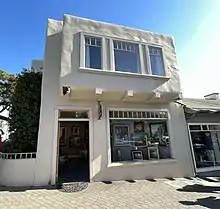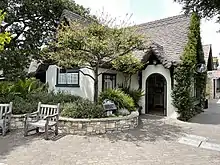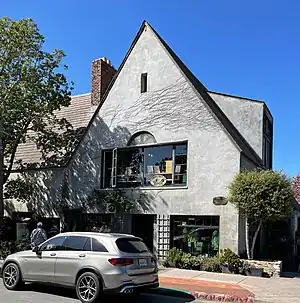Percy Parkes
Percy Parkes (May 2, 1884 –October 23, 1955) was an American master builder in Carmel-by-the-Sea, California. Parkes was one of the main local builders in Carmel through the 1920s and 1930s and the first contractor to build homes on Scenic Drive. His best known commercial buildings are the Seven Arts Building (1928), the Studio Theater (1924), the Dummage Building (1924), and the Percy Parkes Building (1926).[1][2]
Percy Parkes | |
|---|---|
| Born | Earl Percy Parkes May 2, 1884 |
| Died | 23 October 1955 (aged 71) |
| Occupation | Builder |
| Spouses | Charlotte Maud Janoushek
(m. 1910; div. 1920)Jeannette Hoagland
(m. 1921; div. 1932) |
| Children | 4 |
Early life
Percy Parkes was born on May 2, 1884, in Port Clinton, Ohio. He is the son of William Henry Parks (1843-1915) and Ellen Louise Barnes (b. 1862). He was raised in Port Clinton, a town on Lake Erie. He graduated from high school in Port Clinton. Parkes worked as an excursion manager in the passenger department of the Rock Island Railroad Company. In his traveling for the company, he moved to California in 1911. He entered the University of Los Angeles to study law,[3] but left his studies to start his career as a builder.[2] He married Charlotte Maud Janoushek (b. 1888) on December 9, 1910, in Los Angeles and had one child, Earl Percy Parkes Jr., who died in a plane crash while serving as 2nd Lieutenant in the United States Army Air Forces.[4] The couple divorced in May 1920.[5] He married again on December 1, 1921 in Monterey, to Jeannette Hoagland (1893-1964), founder of an early dance troupe, "The Woodland Dancers,".[6] and a longtime resident of Robles del Rio, California.[7] They had three children together.[8][9][10] They divorced in June 1932.[11]
Career
Parkes became involved in real estate in Los Angeles, and in 1911, started his career as a building contractor. He worked as a builder for eight years before he moved his business to Carmel in 1919. Through the 1920s and 1930s, he was one of the main local builders and did residential and commercial work in different architectural styles.[12][3][1] He was the first contractor in Carmel to build homes on Scenic Drive.[10]
In 1924, he and other Carmel residents owned shares in the formation of the Building and Loan Society, located in the Carmel Realty Company offices.[13] He was a member of the Monterey County Builders' Association.[14]
In the 1930s, Parkes led the business and civic development of Dolores Street, between Ocean and 7th Avenues. Some of the buildings he constructed on Dolores Street are the old Pacific Telephone Company office, the Carmel Pine Cone was in the De Yoe Building, Gene and Parvin's Restaurant, and the Dummage Drive-in Market. The Pacific Bell building was originally built by Parkes for Mary Louise Dummage (1870-1952), one Carmel's' first residents, at a cost of $8,000 (equivalent to $132,241 in 2022) to house the office of the Pacific Telephone and Telegraph Company.[13]: p96 [10][13][15]
Downtown commercial buildings
Mary Dummage Shop


Mary Louise (Pearce) Dummage (1870-1952), one of Carmel’s first residents, hired Parkes to design and build a two-story Pueblo Revival style building in 1924, called the First Mary Dummage Shop or the "Corner Cupboard Gift Shop" for $2,500 (equivalent to $42,689 in 2022). It is one of the only Pueblo Revival-style commercial buildings in the village, and is located on the corner of Ocean Avenue and Dolores Street.[13][15][12]
In 1926, Parkes built and designed a Craftsman Fairy tale building for Dummage, based on Hugh W. Comstock's Tuck Box design, for $1,450 (equivalent to $23,969 in 2022). The Mary Dummage Shop is on Dolores Street between Ocean Avenue and 7th Avenue. The building is called the Mary Dummage Shop, and a common name for it was the "White Rabbit," that sold clothing, handknit sweaters, gifts, and home accessories.[16]
Seven Arts Building

The Seven Arts Building is a one-and-one-half-story, commercial building in downtown Carmel. It was built in 1925, for poet mayor Herbert Heron. Parkes built the Tudor Revival-style building that was used as an art gallery and frame shop. The building was designated as a significant commercial building in the city's Downtown Historic District Property Survey, and was recorded with the Department of Parks and Recreation on January 31, 2003. The building has been occupied by the Carmel Bay Company since 1972.[12]
Percy Parkes Building

In 1926, Percy Parkes built, designed, and owned the Spanish Colonial Revival style Percy Parkes Building on Dolores Street between Ocean Avenue and 7th Avenue.[17] He advertised his company as "Percy Parkes, Contractor, Designer, and Builder,” located in the Percy Parkes Building on Dolores Street.[14]
Monte Verde Apartments
In 1915, the El Monte Verde Hotel was run by Mary L. Hamlin 1856-1947). She was the manager of the Pine Inn in 1909. In 1924, Hamlin hired Parkes to undertake a major remodel of the Apartments. In March 1929, Parkes purchased the Monte Verde Apartments and moved them around the corner to face on Monte Verde instead of Ocean Avenue.[18] Today it is the Monte Verde Inn, a Mediterranean style bed and breakfast.[19][20][13]
Works
- Joel and Shama Fineberg House, French-eclectic-style home on Spindrift Road, Carmel Highlands (1921)[21]
- Jo Mora House, American Craftsman-style home on San Carlos southwest of 1st Avenue (1921)[22]
- Charles Sumner Greene Studio, Craftsman-style studio on Monte Verde between 13th and Santa Lucia Avenues (1923)[22]
- Percy Parkes House, Neo-Pueblo-style house on the sand dunes of Carmel Beach (1923)[12]
- Mary Dummage Shop (Corner Cupboard), Pueblo-style building (1924)[15][12]
- Alexis Donati House on San Antonio Avenue (1920s) was demolished[23]
- El Monte Verde Apartments for Mary L. Hamlin (1924)[19]
- Seven Arts Building, Tudor-style (1925)[13]
- Mritz De Hass House, Bungalow-style (1925)[1]
- Mary Dummage Shop, Craftsman-style (1926)[24]
- Jacob F. Kreps House, Craftsman-style bungalow on Torres Street NE on Eighth Avenue (1926)[1]
- Percy Parkes Building, Spanish Colonial-style (1926)[24]
- Elizabeth H. Sullivan House, Craftsman-style (1927)[24]
- Robert A. Norton House, Spanish Eclectic-style on Monte Verde Street NW of 4th Avenue (1928)[1][2]
- William Muench Cottage, Craftsman-style at Guadalupe Street & 5th Avenue (1929)[24]
- Leetes Isalnd West Cottage, at 8th Avenue & Santa Fe Street (1930)[25]
Death
Parkes died on October 23, 1955, in the Monte Verde Apartments he owned in Carmel-by-the-Sea, California. He was buried at the El Carmelo Cemetery in Pacific Grove, California.[10]
References
- Dramov, Alissandra; Momboisse, Lynn A. (2016). Historic Homes and Inns of Carmel-by-the-Sea. Carmel-by-the-Sea, California: Arcadia Publishing. pp. 8, 22, 84–85. ISBN 9780738547053. Retrieved April 22, 2022.
- Kent L. Seavey (January 22, 2003). "Department Of Parks And Recreation" (PDF). National Park Service. Retrieved April 10, 2023.
- Watkins, Rolin G.; Hoyle, Millard F. (1925). History of Monterey, Santa Cruz and San Benito Counties, California: Biographical. Retrieved April 22, 2022.
{{cite book}}:|work=ignored (help) - Diane Lewis Hanger. "Earl Parkes US Army Air Force (1912-1943)" (PDF). www.pineconearchive.com. Carmel-by-the-Sea, California. Retrieved April 10, 2023.
- "Suits For Divorce". The Californian. Salinas, California. May 15, 1920. p. 8. Retrieved April 9, 2023.
- Michael Chatfield. "Glimpses of Carmel's Past". Carmel Magazine. Carmel-by-the-Sea, California. Retrieved April 10, 2023.
- "Jeannette Hoagland Parkes". Carmel Valley Outlook. Carmel Valley, California. May 13, 1964. p. 9. Retrieved April 10, 2023.
- "Ocean Avenue to Have Another New Building". The Californian. Salinas, California. November 30, 1921. p. 5. Retrieved April 9, 2023.
- "Historical Information for Earl Percy Parkes". familysearch.org. Los Angeles, California. Retrieved September 21, 2022.
- "Percy Parkes". Carmel-by-the-Sea, California: Carmel Pine Cone. October 27, 1955. p. 9. Retrieved April 9, 2023.
- "Seeks Divorce From Carmel Contractor". The Californian. Salinas, California. January 26, 1932. p. 1. Retrieved April 9, 2023.
- Kent L. Seavey (January 31, 2003). "Department Of Parks And Recreation" (PDF). National Park Service. Retrieved April 5, 2022.
- Hale, Sharron Lee (1980). A Tribute to Yesterday: The History of Carmel, Carmel Valley, Big Sur, Point Lobos, Carmelite Monastery, and Los Burros. Santa Cruz, California: Valley Publishers. pp. 47, 89, 96. ISBN 9780913548738. Retrieved April 18, 2022.
- Percy Parkes. May 10, 1924. Retrieved April 22, 2022.
{{cite book}}:|work=ignored (help)CS1 maint: location missing publisher (link) - Seavey, Kent (2007). Carmel, A History in Architecture. pp. 98, 105–106. ISBN 9780738547053. Retrieved April 8, 2023.
{{cite book}}:|work=ignored (help)CS1 maint: location missing publisher (link) - The White Rabbit bedecked in holiday finery. December 8, 1994. Retrieved April 23, 2022.
{{cite book}}:|work=ignored (help)CS1 maint: location missing publisher (link) - Dramov, Alissandra (2019). Historic Buildings of Downtown Carmel-by-the-Sea. Carmel-by-the-Sea, California: Arcadia Publishing. p. 78. ISBN 9781467103039. Retrieved June 16, 2022.
- "Purchases Monte Verde Apartments". Carmel Pine Cone. Carmel-by-the-Sea, California. March 15, 1929. p. 3. Retrieved April 10, 2023.
- Neal Hotelling (September 16, 2022). "A Thoroughly Modern Sundial" (PDF). Carmel Pine Cone. Carmel-by-the-Sea, California. pp. 27–29. Retrieved September 20, 2022.
- "17th Annual Carmel Heritage Society Inns Of Distinction". Adventures Of A Home Town Tourist. Carmel-by-the-Sea, California. December 29, 2016. Retrieved April 9, 2023.
- Property Transactions. June 9, 1921. Retrieved April 22, 2022.
{{cite book}}:|work=ignored (help)CS1 maint: location missing publisher (link) - Grimes, Teresa; Heumann, Leslie. "Historic Context Statement Carmel-by-the-Sea" (PDF). Leslie Heumann and Associates1994. Retrieved January 18, 2022.
- Tammara Grippi (May 7, 1999). "Judge to City: Tear down the house". Carmel Pine Cone. Carmel-by-the-Sea, California. Retrieved April 9, 2023.
- "Carmel Inventory Of Historic Resources Database" (PDF). The City of Carmel. Carmel-by-the-Sea, California. Retrieved April 9, 2023.
- Paul, Linda Leigh (2000). "Leetes Island West". Cottages by the Sea, The Handmade Homes of Carmel, America's First Artist Community. p. 116. ISBN 9780789304957. Retrieved April 8, 2023.
{{cite book}}:|work=ignored (help)CS1 maint: location missing publisher (link)